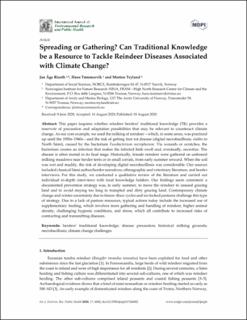Spreading or Gathering? Can Traditional Knowledge be a Resource to Tackle Reindeer Diseases Associated with Climate Change?
Peer reviewed, Journal article
Published version

Åpne
Permanent lenke
https://hdl.handle.net/11250/2673375Utgivelsesdato
2020Metadata
Vis full innførselSamlinger
- Publikasjoner fra CRIStin - NINA [2364]
- Scientific publications [1392]
Originalversjon
International Journal of Environmental Research and Public Health. 2020, 17 (16), . 10.3390/ijerph17166002Sammendrag
This paper inquires whether reindeer herders’ traditional knowledge (TK) provides a reservoir of precaution and adaptation possibilities that may be relevant to counteract climate change. As our core example, we used the milking of reindeer—which, in some areas, was practiced up until the 1950s–1960s—and the risk of getting foot rot disease (digital necrobacillosis; slubbo in North Sámi), caused by the bacterium Fusobacterium necrophorum. Via wounds or scratches, the bacterium creates an infection that makes the infected limb swell and, eventually, necrotize. The disease is often mortal in its final stage. Historically, female reindeer were gathered on unfenced milking meadows near herder tents or in small corrals, from early summer onward. When the soil was wet and muddy, the risk of developing digital necrobacillosis was considerable. Our sources included classical Sámi author/herder narratives, ethnographic and veterinary literature, and herder interviews. For this study, we conducted a qualitative review of the literature and carried out individual in-depth interviews with local knowledge holders. Our findings seem consistent: a documented prevention strategy was, in early summer, to move the reindeer to unused grazing land and to avoid staying too long in trampled and dirty grazing land. Contemporary climate change and winter uncertainty due to freeze–thaw cycles and ice-locked pastures challenge this type of strategy. Due to a lack of pasture resources, typical actions today include the increased use of supplementary feeding, which involves more gathering and handling of reindeer, higher animal density, challenging hygienic conditions, and stress, which all contribute to increased risks of contracting and transmitting diseases.
